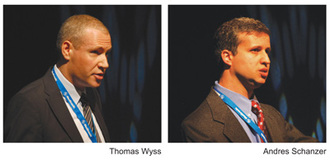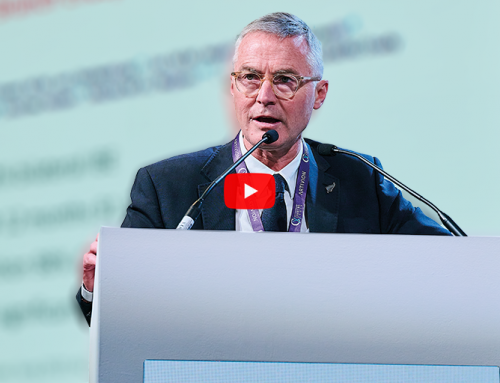These data came both from the UK EVAR trials presented by Thomas Wyss and the large M2S study presented by Schanzer et al which was published online in Circulation immediately following presentation at CX33 yesterday. Chairman Roger Greenhalgh said the session was a historic moment, “Truly head-turning in terms of the evidence emerging,” he said.
The main finding of Thomas Wyss and colleagues, which set out to analyse graft rupture after looking at all endovascular and open repairs performed for up to 10 years in the UK EVAR trials, was that there were no ruptures after open repair. This was a surprise because ruptures after open repair have been documented in the past, as in the UK Small Aneurysm Trial.
Thomas Wyss from Bern, Switzerland, spent a year as vascular research fellow at the Charing Cross Vascular Surgery Research Group. He had access to CT scans of all the EVAR trials’ long follow-up data and conducted an analysis on graft rupture. The data were published in the Annals of Surgery in November 2010.
The aim of the graft rupture analysis, Wyss said, was to establish the incidence of secondary rupture after abdominal aortic aneurysm correction by endovascular and open repair and to investigate factors associated with secondary rupture. In total, 848 elective endovascular repairs and 594 elective open repairs were performed in EVAR 1 and 2, he told delegates.
The EVAR 1 trial aneurysm-related mortality converged at the six-year point, having been significantly higher for open repair at four years. In these later years of follow-up there had to be an explanation for this relative deterioration in the EVAR group at late stages. “This relative improvement of open repair is due to ruptures after EVAR,” he told delegates.
The audit showed that 27 ruptures occurred after endovascular repair – 25 in EVAR 1 and two in EVAR 2. The 27 ruptures were divided into three groups: five ruptures up to 30 days (group A), five ruptures after 30 days with no complications (group B), and 17 late ruptures (>30 days) with complications were included in group C.
“We assume that there was a technical problem behind all of group A and the first rupture (32 days) of group B. A change of protocol, to always perform a pre-discharge CT scan/ or use of any other suitable imaging modality could have revealed problems, which could have been addressed,” Wyss said.
There are four additional sac ruptures which occurred without complications – one failed to attend CT scan follow-up. This left three (11%) which ruptured out of the blue. The patient and clinician, Wyss said, assumed that all was well and “out of the blue” a rupture occurred. “This occurrence is fortunately rare. But, two out of these three died,” Wyss noted.
Cluster of known endovascular complications
The remaining 17 patients (group C) had a cluster of recognisable and known endovascular complications: sac growth, endoleaks type I and III, endoleak type II with sac growth, migration or angulation.
Wyss said that the next steps are to “implement a predischarge computed tomography scan which might reveal problems and prompt immediate treatment to reduce perioperative rupture, confirm the collection and sequence of EVAR complications which predispose to rupture, re-examine the threshold for conversion to open repair and prospectively react to high risk scenarios.”
Wyss et al were surprised to see the statistically very significant factors fed in from the audit, with p=0.0001. They concluded that these results show technology needs to improve device conformability to the aorta.
“Clinical practice must change from today. We need to respect suitability of anatomy for EVAR devices, ensure mandatory pre-discharge CT scan, encourage regular patient follow-up, and correct sac expansion and its underlying cause urgently by either endovascular methods or conversion to open repair,” Wyss said.
60% of EVAR cases do not meet the recommendations
A multicentre observational study conducted in the USA has found low compliance with EVAR device guidelines, and “alarmingly high” post-EVAR aneurysm sac enlargement, raising concern for the long-term risk of aneurysm rupture. The study set out to analyse a large, multicentre, prospectively acquired dataset, representative of real world EVAR practice, containing extensive baseline and postoperative anatomic imaging data.
Andres Schanzer, Worcester, USA, presented the results of the largest investigation to date utilising detailed pre- and post-EVAR anatomic CT imaging data to identify determinants of abdominal aortic aneurym sac enlargement post EVAR.
He said that over 70% of elective infrarenal abdominal aortic aneurysm repair in the United States are performed using EVAR. Schanzer told delegates that baseline aortic and iliac artery anatomic characteristics are the fundamental criteria for appropriate selection of patients for endovascular aortic repair and key determinants of long-term success. “In a large, multicentre cohort, we evaluated compliance with anatomic guidelines for EVAR and the relationship between baseline aortoiliac arterial anatomy and post-EVAR abdominal aortic aneurysm sac enlargement,” he said.
The investigators identified patients with at least one pre-EVAR and at least one post-EVAR computed tomography scan from the M2S, which is an imaging database, in the period 1999–2008.
Explaining the methodology, he said, pre-operative baseline aortic and iliac material anatomic characteristics were reviewed in order to generate a standardised set of morphologic measurements for each patient. Data relating to which specific abdominal aortic aneurysm was implanted was not available. Therefore, the morphologic measurements were compared to the most liberal and the most conservative published anatomic guidelines as stated in each manufacturer’s instructions for use. The most conservative definition was: neck length >15mm, neck diameter 10mm, neck diameter
The primary study outcome was post-EVAR abdominal aortic aneurysm sac enlargement (>5mm diameter increase).
Results
The results of the study showed that in 10,228 patients undergoing EVAR during the study period, 59% had a maximum aneurysm diameter below the 5.5cm threshold where intervention is recommended over surveillance. Only 42% of patients had anatomic characteristics that met the most conservative definition of device instructions for use and 69% met the most liberal definition of device instructions for use.
The five-year post-EVAR rate of abdominal aortic aneurysm sac enlargement was 41%.
Schanzer et al’s study had a mean follow up 31 ± 18 months, the mean number of follow up scans was 3.03 ± 0.9. The important findings that he discussed at CX were:
-
- Only 40% of aneurysms treated with EVAR meet the recommended diameter threshold for treatment (≥5.5 cm).
- Even applying the most liberal instructions for use definition, 30% of treated patients do not meet aortic neck criteria.
- Anatomy deemed acceptable for EVAR has continued to liberalise and several of these factors are independently associated with aortic aneurysm sac enlargement.
- Aortic sac enlargement post EVAR occurred in 40% of patients by five years.
- This incidence is significantly higher than that reported in industry-sponsored trials and reports from single centres of excellence.
- In >30% of patients demonstrating aortic sac enlargement, this was not detected until >3 years postoperatively.
- The incidence of aortic sac enlargement after EVAR seems to be increasing, not decreasing—despite increased surgeon experience and improved device technology.
Schanzer outlined that independent predictors of aortic sac enlargement included: age >80; aortic neck diameter >28mm; aortic neck angle >60 degrees; common iliac artery diameter >20mm and presence of any endoleak on follow-up.
He clarified that some of the limitations of the study were that there was no endograft specific data, no data related to re-interventions, non-consecutive submission of patients to this dataset may introduce selection bias and limit generaliseability. Also, there were no clinical outcomes data available.
Schanzer told delegates that, “Liberalisation of the anatomic characteristics deemed suitable for EVAR has occurred and this is associated with a significant increase in the incidence of aortic sac enlargement thereby reducing durability of EVAR to protect against abdominal aortic aneurysm rupture.
“An honest appraisal of current real world outcomes, with a prospective registry that incorporates blinded imaging review is warranted,” said Schanzer. He also went on to ask if current available commercial devices are truly appropriate for the increasing complex anatomy that they are being applied to?”
Voting results
When the audience of specialists was asked whether they were fixing aortic aneurysms less than 5.5cm in diameter, there was a nearly equal split, with 52% saying that they were fixing such aneurysms and 48% saying they were not. Greenhalgh said, “No matter what the randomised controlled trial data are, several people are breaching that knowingly. Now you have learned that you can get the same problems putting in an endograft unnecessarily and I hope you take his message to heart.”
To the second question, “Should we intervene for sac expansion after EVAR with the defined cluster of factors associated with rupture?” an overwhelming majority of the audience voted that intervention is necessary.








